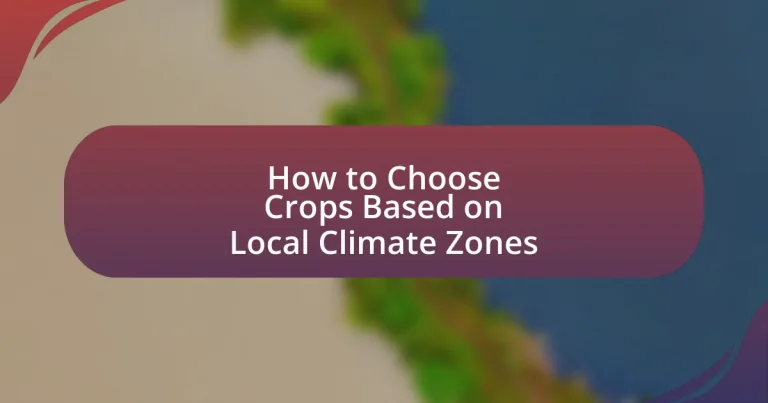The article focuses on the critical relationship between climate zones and crop selection, emphasizing how distinct climate characteristics such as temperature, precipitation, and seasonal variations influence agricultural practices. It outlines the classification of climate zones using the Köppen climate classification system and discusses the factors that determine these classifications. The article further explores how local climate impacts crop growth, yield, and pest management, providing practical tips for farmers on selecting appropriate crops based on their specific climate conditions. Additionally, it highlights the importance of understanding soil types and utilizing historical climate data to optimize agricultural productivity and sustainability.

What are Climate Zones and Why are They Important for Crop Selection?
Climate zones are regions of the Earth categorized by distinct climate characteristics, such as temperature, precipitation, and seasonal variations. These zones are crucial for crop selection because they determine which crops can thrive in specific environmental conditions. For instance, the USDA Plant Hardiness Zone Map classifies areas based on their average annual minimum temperature, guiding farmers in selecting crops that are well-suited to their local climate. Understanding climate zones helps optimize agricultural productivity by ensuring that crops are chosen based on their adaptability to the local climate, thus enhancing yield and sustainability.
How are climate zones classified?
Climate zones are classified primarily based on temperature and precipitation patterns. The Köppen climate classification system, developed by climatologist Wladimir Köppen, categorizes climates into five main types: tropical, dry, temperate, cold, and polar, each further divided into subcategories based on specific climatic conditions. This classification is supported by empirical data, such as average monthly temperatures and annual precipitation levels, which help in understanding the suitability of different crops for each climate zone.
What factors determine the classification of climate zones?
The classification of climate zones is primarily determined by temperature, precipitation, and seasonal variations. Temperature influences the types of vegetation that can thrive in a region, while precipitation levels dictate water availability for crops. Seasonal variations, including the length of growing seasons and frost dates, further refine climate classifications. For instance, the Köppen climate classification system categorizes climates based on these factors, identifying distinct zones such as tropical, arid, temperate, and polar climates, which are essential for agricultural planning and crop selection.
How do climate zones influence agricultural practices?
Climate zones significantly influence agricultural practices by determining the types of crops that can be successfully cultivated in a given area. For instance, tropical climates, characterized by high temperatures and abundant rainfall, support the growth of crops like rice and sugarcane, which thrive in warm, moist conditions. Conversely, arid climates, with limited rainfall and higher temperatures, necessitate the cultivation of drought-resistant crops such as sorghum and millet.
Research indicates that the Köppen climate classification system, which categorizes climates based on temperature and precipitation patterns, directly correlates with agricultural productivity and crop selection. For example, regions classified as Mediterranean climates, with mild, wet winters and hot, dry summers, are ideal for growing olives and grapes. This relationship between climate zones and crop viability underscores the importance of understanding local climate conditions for effective agricultural planning and crop selection.
What role does local climate play in crop growth?
Local climate significantly influences crop growth by determining temperature, precipitation, and sunlight availability, which are essential for photosynthesis and plant development. For instance, crops like corn thrive in warm, humid climates with ample rainfall, while drought-resistant varieties such as sorghum are better suited for arid conditions. Research indicates that specific temperature ranges can optimize yields; for example, wheat typically requires temperatures between 15°C and 25°C for optimal growth. Additionally, local climate affects soil moisture levels, which directly impacts irrigation needs and crop selection. Understanding these climatic factors is crucial for farmers to select appropriate crops that maximize productivity and sustainability.
How do temperature and precipitation affect crop yields?
Temperature and precipitation significantly influence crop yields by affecting plant growth, development, and productivity. Optimal temperature ranges promote photosynthesis and nutrient uptake, while extreme temperatures can lead to heat stress or frost damage, both of which negatively impact yields. For instance, studies show that a 1°C increase in temperature can reduce wheat yields by approximately 6% in some regions.
Precipitation affects soil moisture levels, which are crucial for crop growth. Insufficient rainfall can lead to drought conditions, reducing yields, while excessive precipitation can cause waterlogging and root diseases. Research indicates that crops like maize can experience yield reductions of up to 30% during drought years compared to years with adequate rainfall.
Thus, understanding the interplay between temperature and precipitation is essential for selecting appropriate crops based on local climate zones to maximize agricultural productivity.
What are the implications of seasonal variations on crop selection?
Seasonal variations significantly influence crop selection by determining the types of crops that can thrive in specific climatic conditions throughout the year. For instance, crops like wheat and barley are typically planted in cooler seasons, while corn and soybeans are suited for warmer months. Research indicates that understanding local climate patterns, such as temperature fluctuations and precipitation levels, is crucial for optimizing yield and minimizing crop failure. According to the USDA, selecting crops that align with seasonal weather patterns can enhance productivity by up to 30%, demonstrating the importance of adapting crop choices to seasonal variations.
What are the key considerations when choosing crops for specific climate zones?
Key considerations when choosing crops for specific climate zones include temperature tolerance, precipitation requirements, soil type compatibility, and growing season length. Temperature tolerance ensures that crops can survive and thrive in the local climate, as certain crops require specific temperature ranges for optimal growth. Precipitation requirements are crucial, as some crops need more water than others, making it essential to match crops with the available rainfall or irrigation capabilities. Soil type compatibility affects nutrient availability and root development, so selecting crops suited to the local soil conditions is vital. Finally, understanding the growing season length helps determine which crops can be planted and harvested within the available timeframe, ensuring successful cultivation.
How do soil types interact with climate zones in crop selection?
Soil types significantly influence crop selection in relation to climate zones by determining the suitability of specific crops for growth based on their nutrient content, drainage capacity, and moisture retention. For instance, sandy soils, which drain quickly, are better suited for crops that require less water, while clay soils, which retain moisture, support crops that thrive in wetter conditions. Additionally, the pH level and organic matter content of the soil can affect nutrient availability, which varies across different climate zones. Research indicates that crops like corn and soybeans flourish in fertile, well-drained soils found in temperate climates, while drought-resistant crops such as sorghum are more suited to arid regions with sandy soils. This interaction between soil types and climate zones is crucial for optimizing agricultural productivity and sustainability.
What are the best practices for assessing local climate conditions?
The best practices for assessing local climate conditions include collecting long-term weather data, utilizing climate models, and conducting on-site observations. Long-term weather data, such as temperature, precipitation, and humidity records, provide a historical context that helps identify trends and anomalies in local climate. Utilizing climate models allows for predictions about future climate scenarios based on current data, which is essential for understanding potential impacts on agriculture. On-site observations, including soil moisture levels and microclimate variations, offer real-time insights that can influence crop selection and management strategies. These practices ensure a comprehensive understanding of local climate conditions, which is critical for making informed decisions about crop choices based on climate zones.

How to Analyze Your Local Climate for Crop Selection?
To analyze your local climate for crop selection, start by collecting data on temperature, precipitation, humidity, and frost dates specific to your area. This data can be obtained from local weather stations or agricultural extension services, which often provide climate zone maps and historical weather patterns. For instance, the USDA Plant Hardiness Zone Map categorizes regions based on average annual minimum temperatures, helping farmers identify suitable crops. Additionally, understanding the growing season length and soil moisture levels is crucial, as these factors directly influence crop viability. By correlating this climate data with crop requirements, such as heat tolerance and water needs, you can make informed decisions on which crops will thrive in your local environment.
What tools and resources are available for climate analysis?
Tools and resources available for climate analysis include climate modeling software, satellite imagery, and climate databases. Climate modeling software, such as the Community Earth System Model (CESM), allows researchers to simulate and predict climate patterns. Satellite imagery from sources like NASA’s MODIS provides real-time data on land surface temperatures and vegetation cover, which are crucial for understanding local climate conditions. Additionally, climate databases like the National Oceanic and Atmospheric Administration (NOAA) Climate Data Online offer historical climate data that can inform agricultural decisions based on local climate zones. These resources collectively enhance the accuracy and effectiveness of climate analysis for agricultural planning.
How can weather data be utilized in crop planning?
Weather data can be utilized in crop planning by providing critical information on temperature, precipitation, and seasonal patterns that influence crop growth. This data allows farmers to select crop varieties that are best suited for their local climate conditions, optimizing yield potential. For instance, historical weather data can indicate the average frost dates, helping farmers determine the best planting and harvesting times. Additionally, climate forecasts can inform irrigation needs and pest management strategies, ultimately leading to more efficient resource use and improved crop resilience.
What role do local agricultural extension services play in climate analysis?
Local agricultural extension services play a crucial role in climate analysis by providing farmers with tailored information on climate conditions and their impacts on crop production. These services analyze local climate data, such as temperature, precipitation patterns, and seasonal variations, to inform farmers about the best crop choices for their specific climate zones. For instance, research from the Food and Agriculture Organization indicates that extension services can enhance farmers’ understanding of climate variability, leading to improved agricultural practices and increased resilience to climate change.
How can historical climate data inform crop choices?
Historical climate data can inform crop choices by providing insights into temperature patterns, precipitation levels, and seasonal variations that affect crop growth. For instance, analyzing data over the past 30 years can reveal which crops thrived in specific temperature ranges and moisture conditions, allowing farmers to select varieties that are more likely to succeed in their local climate. Studies have shown that regions with consistent historical climate data can predict crop yields more accurately; for example, the USDA reports that understanding historical frost dates can help farmers determine the optimal planting times for crops like corn and soybeans, thereby maximizing yield potential.
What trends should be observed in historical climate data?
Trends observed in historical climate data include increasing average temperatures, changing precipitation patterns, and rising frequency of extreme weather events. For instance, data from the National Oceanic and Atmospheric Administration (NOAA) indicates that global temperatures have risen approximately 1.2 degrees Celsius since the late 19th century, significantly impacting agricultural zones. Additionally, shifts in precipitation, such as increased rainfall in some regions and droughts in others, have been documented, affecting crop viability and selection. The Intergovernmental Panel on Climate Change (IPCC) reports that extreme weather events, including hurricanes and heatwaves, have become more common, further influencing agricultural practices and crop choices based on local climate zones.
How can farmers adapt to changing climate patterns over time?
Farmers can adapt to changing climate patterns over time by implementing crop diversification and selecting climate-resilient varieties. Crop diversification reduces the risk of total crop failure due to climate variability, as different crops may respond differently to changing conditions. For instance, research indicates that rotating crops can improve soil health and reduce pest outbreaks, which are exacerbated by climate change. Additionally, selecting climate-resilient varieties, such as drought-tolerant or heat-resistant crops, can enhance yields under adverse conditions. According to a study published in the journal “Agricultural Systems,” farmers who adopted these strategies reported improved resilience and productivity in the face of climate challenges.

What are the Best Crops for Different Climate Zones?
The best crops for different climate zones include specific varieties suited to each zone’s temperature and precipitation patterns. In tropical climates, crops like rice, cassava, and bananas thrive due to high temperatures and humidity. In arid climates, drought-resistant crops such as sorghum and millet are optimal. Temperate zones support crops like wheat, barley, and various fruits due to moderate temperatures and seasonal rainfall. In polar climates, hardy crops like kale and certain root vegetables can survive the cold. These recommendations are based on agricultural studies that demonstrate the adaptability of these crops to their respective environments, ensuring successful yields.
What crops thrive in temperate climate zones?
Crops that thrive in temperate climate zones include wheat, barley, oats, rye, and various fruits and vegetables such as apples, pears, and carrots. These crops are well-suited to the moderate temperatures and distinct seasons characteristic of temperate climates, which typically feature warm summers and cold winters. For instance, wheat is a staple crop in many temperate regions due to its adaptability to varying soil types and its ability to withstand cooler temperatures during the growing season. Additionally, research indicates that temperate zones provide optimal conditions for fruit trees like apples, which require a certain number of chilling hours to produce fruit effectively.
What are the specific growing conditions for these crops?
The specific growing conditions for crops vary significantly based on the type of crop and the local climate zone. For example, warm-season crops like tomatoes thrive in temperatures between 70°F and 85°F, require full sun, and need well-drained soil with a pH of 6.0 to 6.8. In contrast, cool-season crops such as spinach prefer temperatures between 50°F and 70°F, can tolerate partial shade, and grow best in fertile, well-drained soil with a pH of 6.0 to 7.0. These conditions are essential for optimal growth and yield, as supported by agricultural studies that emphasize the importance of matching crop selection to specific climate and soil conditions for successful cultivation.
How do pest and disease pressures vary for these crops?
Pest and disease pressures for crops vary significantly based on local climate zones, influencing the types and severity of threats each crop faces. For instance, warmer climates often experience higher pest populations and disease prevalence due to increased reproduction rates and favorable conditions for pathogens. In contrast, cooler climates may limit pest survival and reduce disease incidence, but can also lead to specific challenges such as frost damage or fungal diseases that thrive in moist conditions. Research indicates that crops like tomatoes in humid climates are more susceptible to blight, while drought-resistant varieties may face fewer fungal threats but increased risk from pests like aphids. Thus, understanding the local climate is crucial for predicting and managing pest and disease pressures effectively.
What crops are suitable for arid and semi-arid climates?
Crops suitable for arid and semi-arid climates include sorghum, millet, barley, and certain varieties of legumes such as chickpeas and lentils. These crops are drought-resistant and require less water, making them ideal for regions with limited rainfall. For instance, sorghum can thrive with as little as 12 inches of rainfall annually, demonstrating its adaptability to dry conditions. Additionally, millet is known for its resilience in high temperatures and low moisture, further supporting its cultivation in arid environments.
How do water conservation techniques impact crop selection?
Water conservation techniques significantly influence crop selection by promoting the use of drought-resistant and low-water-demand crops. These techniques, such as drip irrigation and rainwater harvesting, enable farmers to optimize water usage, thereby encouraging the cultivation of crops that can thrive with limited water availability. For instance, research indicates that adopting water-efficient practices can lead to the selection of crops like sorghum and millet, which require less water compared to traditional crops like rice and wheat. This shift not only enhances agricultural sustainability but also aligns crop production with local climate conditions, ensuring better yields in arid and semi-arid regions.
What are the benefits of drought-resistant crop varieties?
Drought-resistant crop varieties offer significant benefits, including improved yield stability in arid conditions. These crops are specifically bred to withstand water scarcity, which allows farmers to maintain productivity even during periods of low rainfall. Research indicates that drought-resistant varieties can increase crop yields by 20-50% compared to traditional varieties under drought conditions, thereby enhancing food security. Additionally, these crops require less irrigation, reducing water usage and associated costs, which is crucial in regions facing water shortages.
What crops are ideal for tropical climates?
Crops ideal for tropical climates include rice, cassava, maize, and various fruits such as bananas and pineapples. These crops thrive in warm temperatures and high humidity, which are characteristic of tropical regions. For instance, rice is a staple food in many tropical countries and requires abundant water, making it well-suited for the wet conditions found in these areas. Cassava is drought-resistant and can grow in poor soils, while maize is adaptable and widely cultivated in tropical zones. Additionally, fruits like bananas and pineapples flourish in the warm climate, contributing significantly to local economies and diets.
How does humidity affect crop growth in tropical regions?
Humidity significantly influences crop growth in tropical regions by affecting water availability and plant physiological processes. High humidity levels can enhance transpiration rates, leading to increased nutrient uptake and growth, but excessive humidity may also promote fungal diseases and reduce crop yields. Research indicates that optimal humidity levels, typically between 60% and 80%, support healthy crop development, while levels above 80% can lead to detrimental effects such as reduced photosynthesis and increased susceptibility to pests and diseases. For instance, studies have shown that crops like rice thrive in high humidity, while others, such as maize, may suffer under excessively humid conditions.
What are the challenges of pest management in tropical agriculture?
The challenges of pest management in tropical agriculture include high biodiversity, climate variability, and limited access to resources. High biodiversity in tropical regions often leads to a complex ecosystem where numerous pest species coexist, making it difficult to target specific pests effectively. Climate variability, characterized by unpredictable rainfall and temperature fluctuations, can exacerbate pest outbreaks and complicate management strategies. Additionally, limited access to financial resources, technology, and training for farmers hinders the implementation of effective pest management practices. These factors collectively contribute to the difficulties faced in managing pests in tropical agricultural systems.
What practical tips can help farmers choose the right crops based on local climate zones?
Farmers can choose the right crops based on local climate zones by assessing temperature ranges, precipitation patterns, and soil types specific to their area. Understanding the USDA Plant Hardiness Zone Map helps farmers identify which crops can thrive in their climate, as it categorizes regions based on average annual minimum temperatures. Additionally, analyzing historical weather data allows farmers to predict seasonal variations and select crops that are resilient to local conditions. For instance, crops like corn and soybeans are suited for warmer climates, while cool-season crops such as broccoli and peas thrive in cooler zones. This targeted approach ensures that farmers maximize yield and minimize risks associated with climate variability.





